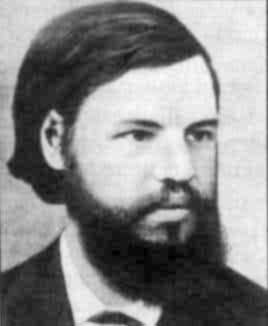


 تاريخ الرياضيات
تاريخ الرياضيات
 الرياضيات في الحضارات المختلفة
الرياضيات في الحضارات المختلفة 
 الرياضيات المتقطعة
الرياضيات المتقطعة
 الجبر
الجبر
 الهندسة
الهندسة 
 المعادلات التفاضلية و التكاملية
المعادلات التفاضلية و التكاملية 
 التحليل
التحليل
 علماء الرياضيات
علماء الرياضيات |
Read More
Date: 17-1-2017
Date: 2-2-2017
Date: 16-1-2017
|
Died: 19 July 1878 in St Petersburg, Russia

Egor Ivanovich Zolotarev's father, Ivan Zolotarev, was a watchmaker. Egor Ivanovich attended the Gymnasium in St Petersburg completing his school education in 1863. It was a school career of great distinction and he received a silver medal when he graduated.
After leaving school Zolotarev enrolled at the Faculty of Physics and Mathematics of St Petersburg University. There he attended lectures by Chebyshev and A N Korkin, graduating with his first degree in 1867. He then continued his studies at the Faculty of Physics and Mathematics investigating an indeterminate equation of degree three. For this work he was awarded a Master's degree in 1869.
It is worth commenting that a Master's degree in Russia at this time was closer in standard to what might be expected of a doctoral dissertation in a British or American university in the present time. The doctoral dissertation that Zolotarev went on to write would be closer to the German habilitation. In 1874 he submitted this doctoral dissertation on algebraic integers and was awarded the degree. Two years later Zolotarev was appointed as Professor of Mathematics at St Petersburg Faculty of Physics and Mathematics. He also became an assistant in applied mathematics at the St Petersburg Academy of Sciences.
Then he made two trips abroad, visiting Berlin where he attended lectures by Kummer, Weierstrass and Paris where he had many mathematical discussions with Hermite. We will indicate below some of Zolotarev's remarkable mathematical achievements some of which were consequences of problems which he discussed with Kummer and Hermite while on his trips. All his results were produced over a comparatively short time period for he died two years after being appointed a professor. His career ended when he fell under a train and died shortly after of blood poisoning.
In a short eleven year career Zolotarev produced fundamental work in approximation theory, quadratic forms, algebraic numbers and elliptic integrals. During this tragically short career he published 28 papers and books. Let us first comment on his work on algebraic numbers.
He studied rings of integers in algebraic number fields, giving a divisibility theory for such rings developing ideas which had been introduced by Kummer. He studied local rings and semilocal rings and proved certain results on principal ideal domains. He also introduced ideas which were essentially what today are called valuations.
The paper [7] looks at both the published work of Zolotarev, and also manuscripts preserved in libraries in Moscow and St Petersburg, relating to his work on elliptic functions. Nalbandjan was able to examine Zolotarev's notebooks, including lecture notes he made while a student. Zolotarev emphasised the relationship between elliptic functions and functions of a complex variable. In particular he applied his theory of complex integers to the integration of elliptic differentials. Abel had shown when certain elliptic differentials could be integrated in logarithms but his methods was of little practical use. Zolotarev was able to give a much more effective solution.
Zolotarev worked with Korkin on quadratic forms. Hermite had posed the problem of finding the minimal values of quadratic forms in n variables whose coefficients were real. They were able to give complete solutions in the case of four variables and of five variables.
Zolotarev posed four problems in approximation theory all of which he was able to solve. The first two of the problems he examined attempted to minimize max{ |p(x)| : -1 ≤ x ≤ 1} over polynomials p(x) whose coefficients satisfied a given condition. The third and fourth problems were concerned with optimal approximations of a rational function on a given interval subject to given restrictions elsewhere. He found the nth degree polynomial with two of its coefficients fixed which is closest to zero. In [10] the best approximation to 1/(1 + x) on [0, 1] by a quadratic polynomial is given as an example of how Zolotarev's methods can be used
Books:
Articles:



|
|
|
|
التوتر والسرطان.. علماء يحذرون من "صلة خطيرة"
|
|
|
|
|
|
|
مرآة السيارة: مدى دقة عكسها للصورة الصحيحة
|
|
|
|
|
|
|
نحو شراكة وطنية متكاملة.. الأمين العام للعتبة الحسينية يبحث مع وكيل وزارة الخارجية آفاق التعاون المؤسسي
|
|
|